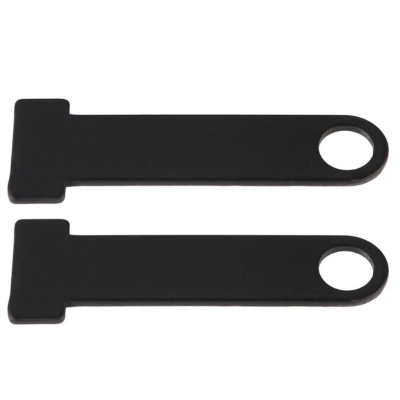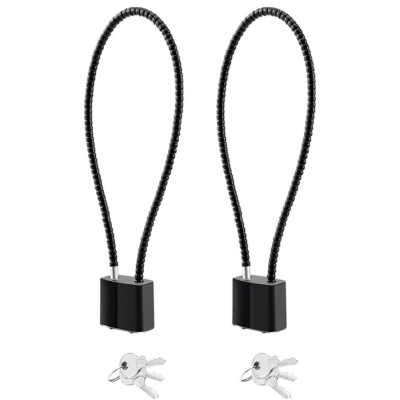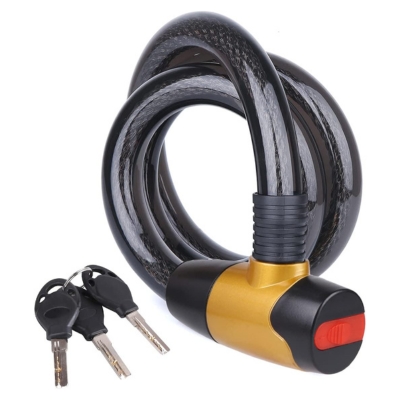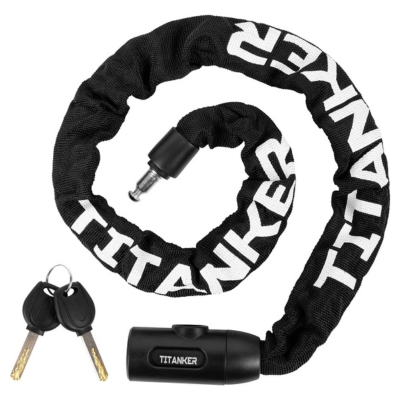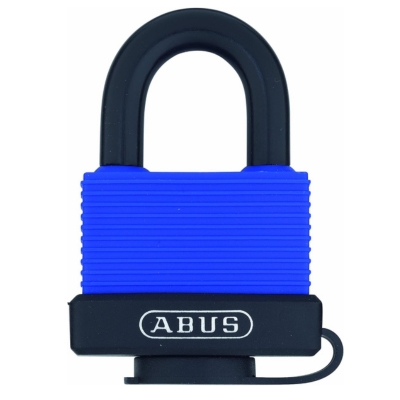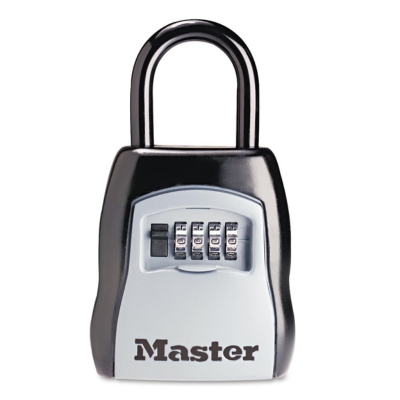How to Lock Helmet to Motorcycle
I understand the importance of keeping your helmet safe while you're not riding. We'll explore several ways to lock your helmet to your motorcycle effectively and securely. From built-in locks to alternative methods, there's a solution for everyone.
Lock Helmet to Motorcycle Using D-Ring Lock
EVGATSAUTO Helmet strap D-ring lock
A simple way to lock your helmet to your motorcycle is by using a D-ring lock. To do this, run the lock through the provided D-ring on the helmet strap and then attach the lock to a secure part of your motorcycle.
This method is effective and economical, as D-ring locks are usually affordable. Our favorite D-ring lock is the EVGATSAUTO Helmet strap D-ring lock, but you can also opt for the Qii lu Helmet Strap D-Ring Lock.
Lock Helmet To Motorcycle Using Gun Lock
DELSWIN Cable Gun Lock with Keys
Another great alternative to locking your helmet safely is using a gun lock. These locks are specially designed for firearms, but they also work well for securing helmets.
Simply thread the cable through the helmet's D-ring or strap and secure it to a sturdy part of the motorcycle. Most gunlocks fit perfectly and offer a portable and affordable solution for helmet security.
The best gun locks for securing your helmets are the DELSWIN Cable Gun Lock with Keys, which deliver exceptional performance.
Use Bicycle Cable Lock for Motorcycle Helmets
A bicycle cable lock can work wonders when it comes to securing your helmet to your motorcycle. These locks are typically long enough to wrap around your bike's frame and through your helmet's D-ring or strap, providing a secure and versatile method of locking your helmet.
Keep in mind that cable locks can be a bit bulkier than other options. The top cable locks for motorcycle helmets include the Kryptonite KryptoFlex Bike Lock Cable. Another top choice is the Fobozone cable lock, which ensures durable performance.
Secure Helmet with Motorcycle Chain Lock
Titanker Bike Chain Locks
Another way to ensure your helmet is safely locked to your motorcycle is by using a motorcycle chain lock. Wrap the chain around a stable part of your bike, like the motorcycle frame, and thread it through your helmet's D-ring or strap.
Then, lock the helmet in a steady position using the provided padlock or combination. This locking mechanism offers excellent protection but can be heavier than other options.
Some of the popular motorcycle chain locks include Titanker Bike Chain Locks and WANLIAN Bike Chain Lock.
Lock your Helmet with a Padlock
ABUS 70/45 All Weather Solid Brass Padlock
To lock your helmet to your motorcycle using a padlock, first, find a secure attachment point on your bike, such as the frame or handlebars. Pass the helmet's chin strap or D-ring through this point, then reattach it to the helmet.
Insert the padlock's shackle through the free end of the helmet strap or D-ring and lock it securely. Test the setup by tugging the helmet to ensure it's firmly attached.
An example of a suitable padlock for this purpose is the ABUS 70/45 All Weather Solid Brass Padlock, designed to provide helmet security and deter theft.
Use Keyless Security
Master Lock 5400D Lock Box
To utilize keyless security with four combinations for locking your helmet to your motorcycle, start by selecting a keyless security device equipped with a four-digit combination lock mechanism.
Set your preferred combination following the manufacturer's instructions. Then, pass the lock through the D-ring and secure it to a fixed part of your motorcycle.
Verify that the helmet is securely positioned and won't interfere with your riding, and ensure the lock is properly engaged.
An example of keyless security is the WordLock PL-096-A1 Combination Bike Lock. Another great option is the Master Lock 5400D Lock Box, which offers reliable keyless protection for your helmet and gear.
Use Built-In Motorcycle Locks
Many motorcycles come with built-in helmet locks, usually located near the rear or side of the bike. To use this method, insert your helmet's chin compartment through the lock's mechanism and secure it in place.
This bike’s stock lock provides a convenient option as you won't need to carry any additional locks. Check your motorcycle's manual for information on using the built-in motorcycle lock.
Use the Motorcycle's Frame to Lock Helmets
Lastly, you can use your motorcycle's frame as a lock. Find a secure part of the frame, like a pillion grab rail or a suspension component, and slide the helmet's D-ring or strap through it.
While this method doesn't require additional locks, it offers a convenient and reliable way to secure your helmet. More importantly, watch this video for more tips on locking your helmet to prevent it from being stolen.
Factors to Consider When Selecting a Lock
Securing your helmet is an essential part of protecting your investment and preventing theft. We'll cover the key factors to consider when choosing a lock for your motorcycle helmet.
- Type of Lock: Various types of locks offer different levels of security and convenience. The most common helmet locks are cable locks, combination locks, and built-in motorcycle helmet locks. Depending on your preference, each has its advantages and drawbacks.
- Security Level: Think about the level of security you need. Lightweight cable locks and combination locks can be easily carried but may offer less protection compared to sturdier options like chain locks.
- Ease of Use: Some locks can be more challenging to use than others. You might want a lock that can be easily secured and removed without hassle.
- Portability: Your lock should be portable enough to carry while riding. Heavy-duty locks may offer more security but can be burdensome to carry around.
- Compatibility with Helmet: Ensure your lock is compatible with your helmet's buckle or the D-ring design.
- Cost: Consider your budget and how much you are willing to spend on a lock.
Where to Attach Your Helmet
It's crucial to secure your helmet properly when it's not in use to ensure safety and prevent damage. Here are common places to attach your helmet to your motorcycle:
- Helmet Hook: Some motorcycles have a designated helmet hook, often located under the passenger seat or on the side of the frame. You can hang your helmet by its D-ring or strap onto this hook for easy access.
- Top Box or Tail Bag: If your motorcycle has a top box or tail bag, you can place your helmet inside it. These lockable storage compartments provide security for your helmet and other belongings.
- Backrest or Sissy Bar: On cruiser-style motorcycles with a backrest or sissy bar, you can secure your helmet by hanging it over the backrest or sissy bar. Ensure it's stable and won't slide off during the ride.
- Tank Bag: Some tank bags have external straps or pockets specifically designed for holding a helmet. Check your tank bag's features to see if it offers this option.
- Lockable Helmet Holder: Consider investing in a lockable helmet holder accessory that attaches to your motorcycle's frame or handlebars. These holders provide a secure and visible location for your helmet.
Helmet Security and Legal Requirements: Compliance and Consequences
As mentioned, you can use various methods, such as built-in motorcycle locks, padlocks, helmet lock devices, gun locks, or bicycle chain locks, to lock your expensive helmet to stop it from being stolen. By implementing these techniques, you're securing your helmet and complying with the law, helping you avoid penalties and fines.
Let’s explore crucial aspects of helmet security and legal compliance, ensuring you're well-informed in every situation.
When it comes to helmet security, there are a few crucial points:
- Positioning: Attach your helmet to a secure location, such as handlebars, passenger pegs, or the seat.
- Additional security: Use a secondary or more robust lock, if possible.
- Visibility: Choose a conspicuous location to deter potential thieves.
In many jurisdictions, helmets are mandatory for motorcyclists, and properly securing them is a legal requirement. Non-compliance can result in consequences like fines, license suspensions, or vehicle impoundment in some cases.
Moreover, having a secure helmet ensures your safety and protection in the event of an accident. So, it's essential to familiarize yourself with helmet security practices and the legal implications, as being compliant saves you from potential penalties and helps maintain your overall safety on the road.




